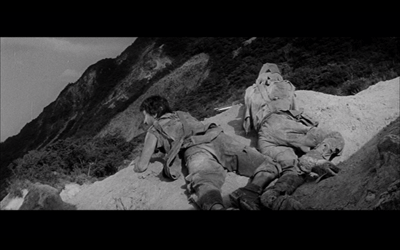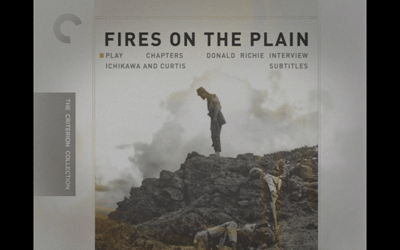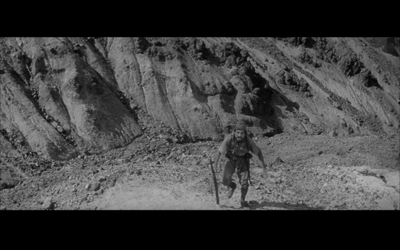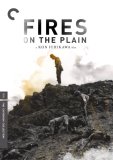| Reviews & Columns |
|
Reviews DVD TV on DVD Blu-ray 4K UHD International DVDs In Theaters Reviews by Studio Video Games Features Collector Series DVDs Easter Egg Database Interviews DVD Talk Radio Feature Articles Columns Anime Talk DVD Savant Horror DVDs The M.O.D. Squad Art House HD Talk Silent DVD
|
DVD Talk Forum |
|
|
| Resources |
|
DVD Price Search Customer Service #'s RCE Info Links |
|
Columns
|
|
|
Fires on the Plain - Criterion Collection
THE MOVIE:

"War is hell" isn't really a novel message anymore, and it hasn't been for some time. Even so, most works of art, even ones with this message, don't really go as far as they could to illustrate how hellish the situation can be. It's hard not to make a hero of your main character, to steer past the things that make service in wartime a noble pursuit; there's something unavoidably worthy of respect that the soldiers know it's hell they face and still they face it anyway. So, when a movie comes along that shows us to what extent conflict can ravage the human soul, it still shocks us, still unnerves its audience. No one emerges as a hero from Kon Ichikawa's 1959 motion picture Fires on the Plain (a.k.a. Nobi), no one even tries to fight the good fight. It's a dour and grisly portrait of how battle can change the landscape of a particular patch of land until you will believe it is hell on earth and reminds us of how far we may be asking men to go when we ask them to stand up and fight.
Eiji Funakoshi plays Tamura, a hapless private in the Japanese army who is stationed in the Philippines during World War II. As the film opens, Tamura is being berated by his staff sergeant, who is sending him back to the field hospital a third time to be treated for his tuberculosis. If he can't work, he's useless on the front, and if the hospital rejects him yet again, Tamura is instructed to throw himself on his own grenade. He takes the long trek back to the medical station, and of course, they refuse him once more. The doctor tells him if he can walk, he doesn't belong there among the real wounded.
At this point, Tamura becomes an outcast, joining a group of other soldiers who have also been stuck in this sort of limbo, unfit to serve but not committed enough to die. He's not a part of the army his uniform represents, he's not sick enough to be taken care of, and he's not even in his own country. The world beyond him is a terrifying unknown element. All he can see on the horizon are plumes of smoke. Everyone thinks they most be some kind of signal, they just don't know of what.
When the enemy attacks and destroys the hospital, Tamura is once again scattered to the wind. He knows he should use that grenade, he knows that there is only danger out there, but he begins to wander. His journey leads him from one atrocity to another, a trail of corpses and the desperate living in search of their way out. Word has come down that the Japanese forces are gathering in one spot and then they will be shipped out, so everyone wants to get there. Tamura will kill, and he'll see killing; he'll forage for food, and he'll see foraging and even theft; he'll witness people giving in and giving up, and he'll witness the price that might be paid when his fellow troopers completely let go. Tamura will even let go himself, first of the trappings of a soldier and then eventually his own humanity. Trapped out in the wilderness with two of the other hospital refugees, Tamura will find himself in a sort of Treasure of the Sierra Madre situation, only the treasure isn't gold, it's survival. Just how will Tamura find his way back to being a person again? The answer may reside in that tower of smoke that has suddenly returned, but once again, if it's a signal, it's all going to be a matter of how it's read.
Kon Ichikawa isn't afraid to celebrate the power of the human spirit. Anyone who has seen his vision of the lone African runner in his documentary Tokyo Olympiad knows the director believes that one man can overcome impossible odds. This makes it all the more impressive that he had previously gone to the totally opposite to show the depths of individual degradation. Tamura doesn't engage nearly as much as he watches, but like Jerzy Kosinski's young protagonist in his novel The Painted Bird, there is only so long any one person can let the horrors of war rage around him until he succumbs to them. Also as in Kosinski, the world surrounding the focal character is so transformed by the destruction, it loses all earthly familiarity. Hell may just be a metaphor here, but when Tamura looks back over the river bed that was supposed to be the border of his freedom and sees the corpses that piled up while he escaped, it's as close to seeing Hell on the physical plane as you're likely to get.
Though Fires on the Plain is bleak, it's not unrelenting. There is some laughter in the face of destruction. In one scene, a soldier finds a nice pair of boots abandoned in the mud. He trades them for his own shoes, which are starting to become worn down. The next soldier then trades this newly discarded pair for his own, and so on, each pair of shoes getting worse and worse until the last pair has no soles on them at all. Just as most people do when faced with grisly circumstances, Ichikawa indulges in a little gallows humor to keep his audience's spirit up long enough to get to the final destination. So, don't worry, though Fires on the Plain will weigh heavy on you, it won't crush you. Like Tamura, you may end up punch drunk (he gets more comical the farther he goes over the edge), but you'll still be standing.
Ichikawa and his wife and frequent collaborator, screenwriter Natto Wada, working from a novel by Shohei Ooka, weren't trying to create a movie that represented the experience of every soldier or say all men who served in the Philippines engaged in the poor behavior represented on the screen. When you sit back and look at it, there is no propaganda here at all. No one espouses a message. Quick scenes with the American soldiers don't vilify them. Ichikawa isn't teaching us, rather he's using Fires on the Plain to show us how far things could go were circumstances to pile up as they do and trusting the meaning to be obvious. Thus, Tamura is meant to serve as a reminder, or maybe more accurately, a warning. Tamura stands in stark relief against the regular cinematic soldier who is far more ready to pick up his rifle and rush across the trenches to save the day. Fires on the Plain is the other side of that story, showing the men who might be on the receiving end of the movie hero's bullets. It's a harrowing wake-up call. War may always be hell, but it's not often that we experience it burning this coldly.

THE DVD
Video:
Fires on the Plain is part of the esteemed Criterion Collection, and the restoration job done for this new digital transfer is of the high caliber Criterion delivers more and more reliably these days. Put on disc at a 2.35:1 aspect ratio, this a is very wide widescreen transfer, and the black-and-white cinematography is wonderfully sharp, cleaned up and polished for the DVD age. A handful of shots still have some scratchy elements to them, but they are so few, it would suggest they were unavoidable. Except for those minor instances, the picture quality for Fires on the Plain earns very high marks.
Sound:
A monaural mix of the original Japanese soundtrack is very good, creating a fine balance between all the natural sounds of the open-air setting and the often dramatic orchestral score. The newly done (and wholly optional) English subtitles are well-written and easy to read.
Extras:
The lead bonus feature on the disc is a twelve-minute interview with Japanese film scholar Donald Ritchie. The author talks about his impressions of Fires on the Plain, critical reactions to the film, and the larger career of the director. In addition to this featurette, there are twenty minutes of recent interviews with Kon Ichickawa and actor Mickey Curtis. Curtis plays Nagamatsu in the film, the hospital outcast with the freshest face, and the one character in the movie who crosses the farthest distance, becoming the least recognizable in comparison to his former self. Curtis could be the subject of a movie himself, having been a rock idol in Japan at the time Fires on the Plain was made. Both actor and director go into detail about the unique production of the film, as well as their background and the background of the original story.
Off the DVD, the accompanying booklet has a lengthy new critical essay by Chuck Stephens, an editor at Film Comment.
FINAL THOUGHTS:
Highly Recommended. I wouldn't call Kon Ichikawa's Fires on the Plain – Criterion Collection an anti-war film so much as I'd call it a realist's war film. Rather than build his story around big explosions and the thrill of battle, Ichikawa instead brings the human drama front and center, directing his spotlight on a soldier who is left to his own devices when the guns stop blazing. He poses the question, "When stranded on the bombed-out landscape after the fighting has calmed, what will those left behind do to survive?" It's bleak and it's chilling, and yet Fires on the Plain is also completely engrossing. It's the post-action picture as morality play, the journey of the individual recast with Dante-esque overtones. Ichikawa doesn't have to hit you over the head with a message because the story is so truthfully crafted, to state the message outright would be redundant. Once you've see Fires on the Plain, the movie will get under your skin, and you'll find it impossible to forget.

Jamie S. Rich is a novelist and comic book writer. He is best known for his collaborations with Joelle Jones, including the hardboiled crime comic book You Have Killed Me, the challenging romance 12 Reasons Why I Love Her, and the 2007 prose novel Have You Seen the Horizon Lately?, for which Jones did the cover. All three were published by Oni Press. His most recent projects include the futuristic romance A Boy and a Girl with Natalie Nourigat; Archer Coe and the Thousand Natural Shocks, a loopy crime tale drawn by Dan Christensen; and the horror miniseries Madame Frankenstein, a collaboration with Megan Levens. Follow Rich's blog at Confessions123.com.
|
| Popular Reviews |
| Sponsored Links |
|
|
| Sponsored Links |
|
|
| Release List | Reviews | Shop | Newsletter | Forum | DVD Giveaways | Blu-Ray | Advertise |
|
Copyright 2024 DVDTalk.com All Rights Reserved. Legal Info, Privacy Policy, Terms of Use,
Manage Preferences,
Your Privacy Choices | |||||||














